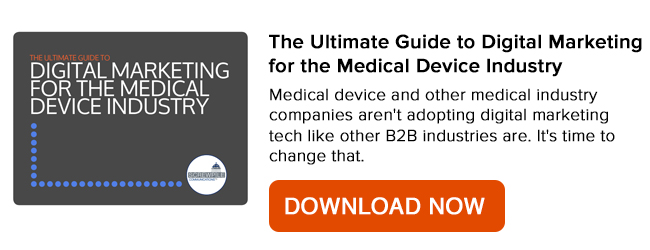When you set out to build a medical device marketing plan, you’re not really starting from scratch. Though you may not have thought about these strategies in terms of marketing, your sales team is already implementing an approach they’ve honed based on experience with your prospects and customers.
Your first task in creating your new marketing plan is to gather the knowledge your sales representatives have acquired through years of contact with your market and determine how best to incorporate that information into your marketing plan.
Although the online sales process differs in some ways from the one your sales team engages in, the core is the same: the same triggers apply, your prospects have the same problems to solve and perceive the same obstacles and the stages of the sales cycle are the same.
Because most of that sales cycle now takes place before a prospect ever makes contact with your company, you must recreate the steps on the path your prospects follow to become customers.
Clearly Articulate the Steps in the Sales Process
Replicating your sales process online requires more than a general understanding of the strategies your sales team employs and the obstacles they encounter. Take the time to clearly map out each step in the process and attach the goals, questions, concerns and obstacles associated with each to that step.
Once you have charted the cycle and all of the attendant considerations, it’s time to plan content that will help you move those prospects down the path toward conversion before you’ve ever had the opportunity to speak with them. In short, determine what type of materials will guide those prospects to each conversion point.
The Right Delivery Method is as Important as the Right Content
Understanding the questions and concerns raised by your prospects is key to creating effective content, but it’s only one piece of the puzzle. Another important consideration is the type and placement of content that will be most effective at each stage. For example, blog posts can be a very effective way to draw new prospects to your website, acquaint them with your business and give them the opportunity to see your expertise.
Similarly, YouTube videos, Quora answers and other social media posts can be an effective means of introducing yourself to potential prospects. When planning content for those outlets, you’ll want to address the interests of and questions raised by prospects in the very early stages of the sales cycle.
However, when a prospect is further along the Buyer's Journey, your team will undoubtedly tell you that the questions become more specific, and that prospects express a handful of predictable barriers to conversion. You’ll also need content that speaks to those questions and concerns, but the most effective format and placement will likely be different.
Prospects who have reached the stage of specifically researching your company and your product will be looking for more in-depth information, along with hard data to back up the value of your product. These more advanced prospects are also more likely to be willing to trade their contact information for the materials they’re looking for. So, that higher-level, more detailed information may be best placed in white papers and other in-depth premium content that requires form completion to download.
Sales and Marketing Alignment
Replicating the early stages of your sales process online helps reach those prospects who aren’t yet ready to make contact, allows you to reach more prospects and makes it easier and more cost-effective to move those prospects along the sales pipeline. However, you can’t expect content to take those prospects across the finish line. As they move closer to the decision point, your sales team will have to step back in and close the deal.
For that to play out effectively, the sales and marketing teams must be on the same page. That alignment begins when your marketing team talks with sales and gathers the information necessary to create the right content. But, just as the sales process must be explicitly mapped out in order to duplicate the steps online, sales and marketing integration requires a very clear process that is understood and agreed upon by both teams.
That means marketing providing guidance on how to use content in the sales process, the sales team acquainting itself with the materials prospects will have seen before making contact and both teams agreeing on the point at which leads have been sufficiently warmed up and eased along the pipeline to be handed off to the sales team.
With a process that’s integrated from beginning to end, your medical device marketing plan can advance prospects along the pipeline and facilitate the sales process while saving your company time and money.
This post originally appeared on the Screwpile Communications blog. Screwpile Communications is a HubSpot Partner Agency located in Annapolis, Maryland.


